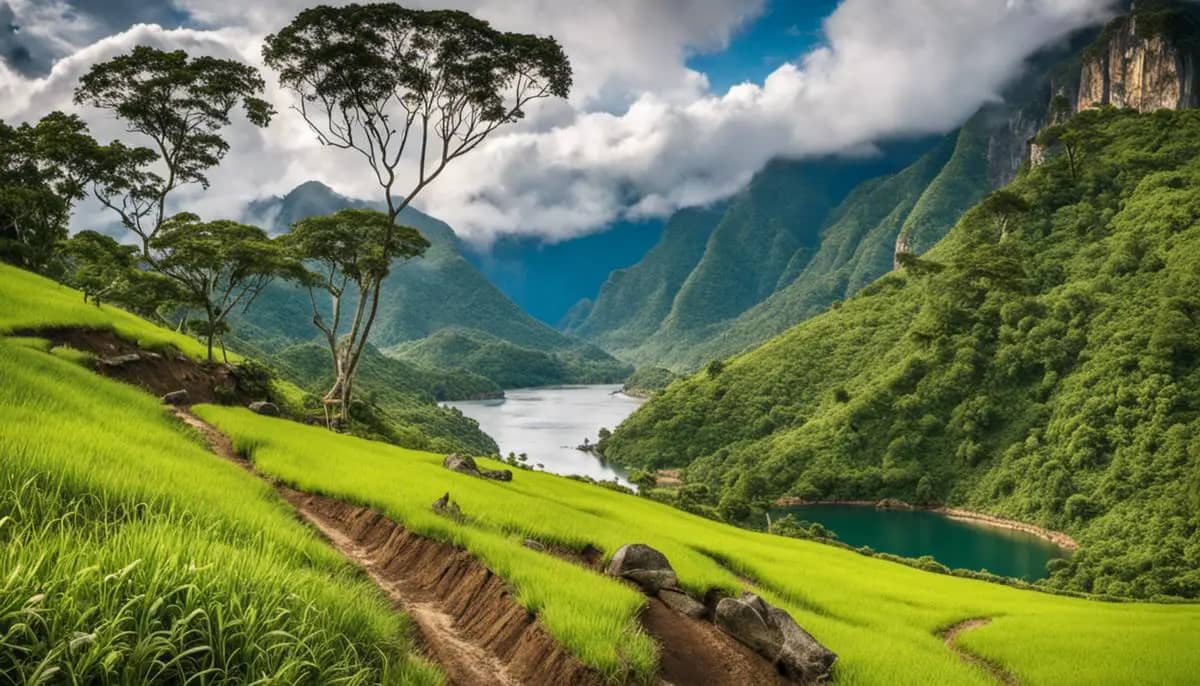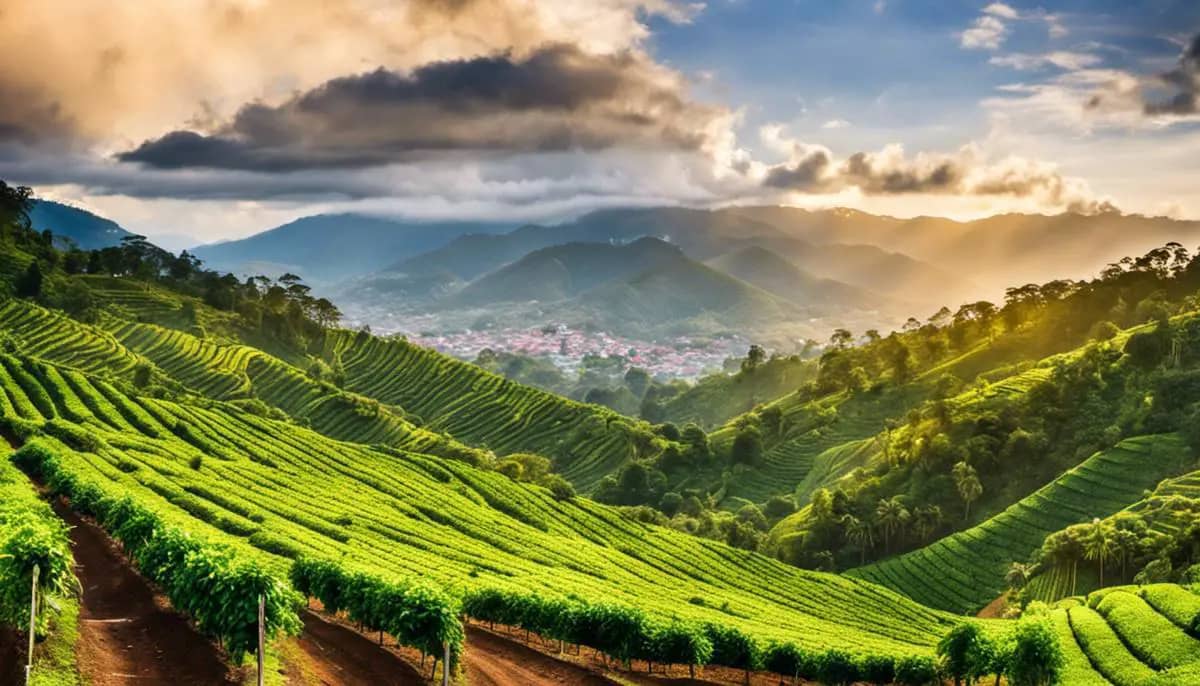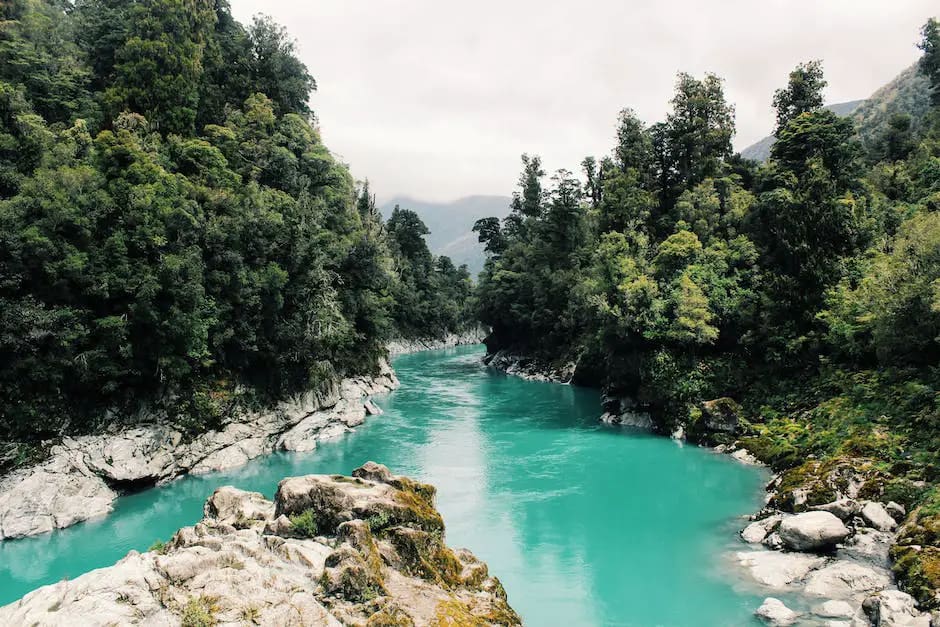Rich in cultural heritage, bursting with natural beauty, and teeming with vibrant cities, Colombia is a treasure trove for travellers. This comprehensive guide delves into Colombia’s diverse geography, from its stunning coastal regions and majestic mountain peaks to its dense rainforests, all contributing to a unique mosaic of climate zones. We’ll look at the must-visit areas and delve into the heart of Colombia’s rich culture and heritage, painting a vivid image of the pulsating rhythms of Colombian music, the colourful festivals and the mouth-watering local cuisine. Prepare to embark on an unforgettable journey into Colombia’s biodiversity, uncovering its status as a megadiverse country and the myriad outdoor adventures it has to offer. And, to ensure your journey is seamless, this guide houses indispensable practical information for travelling in Colombia.
Understanding Colombia’s Geography and Climate
Geography of Colombia
Straddling the northwestern corner of South America, Colombia is a country endowed with a diverse landscape that ranges from sun-soaked Caribbean beaches to lofty Andean peaks, dense tropical rainforests and open savannahs. Colombia is split into six major natural regions, each unique in its own topographical character: the Andean region, the Caribbean region, the Pacific coast region, the Orinoco region, the Amazon region and the insular region, which includes islands in both the Caribbean and Pacific Oceans.
The Andean region, home to Bogotá the nation’s capital, boasts majestic mountain ranges that are further divided into three branches, cordilleras: Occidental, Central and Oriental. The latter houses the tallest peak in Colombia, Pico Cristóbal Colón, which reaches a dizzying height of 5,700 meters above sea level.
The Caribbean and Pacific coastal regions present a stark contrast to the mountainous Andean region with their low-lying plains and swamp lands, liberally dappled with pristine beaches, lush mangroves and coral reefs.
Further east, the Orinoco region boasts vast savannahs and wetlands teeming with biodiversity while the Amazon region, occupying almost half of the country’s land area, is typified by dense tropical rainforests that provide sanctuary to untold number of species and indigenous tribes.
Lastly, the insular region includes the Caribbean island of San Andrés and Providencia and a number of Pacific islands. Being the only part of Colombia with volcanic origin, it presents a stark contrast to other regions in its geology and ecosystem.
Climate of Colombia
Due to its geographical diversity, Colombia is home to six main climate zones: tropical rainforest, savannah, steppe, desert, mountain, and oceanic climates. This range in weather patterns adds a thrilling yet potentially challenging aspect to your travels.
Specifically, the coastal regions offer a tropical and humid climate, with temperatures ranging between 24°C and 33°C year-round. The moisture adds to the fertility of the lush rainforests and diverse ecosystems you’ll find here.
Because of its equatorial location, Colombia’s Amazon rainforest area maintains consistent temperatures, hovering around 26-30°C, accompanied by high humidity and significant rainfall throughout the year.
Contrastingly, in the highland city of Bogotá, temperatures can vary between 8°C and 19°C due its high altitude. While days can be warm, nights are often cool or even cold. This pattern is typical in the Andean region where altitude plays a role in the climate, more so than seasonal differences do.
The Guajira Peninsula, in contrast, has a harsh desert climate, with temperatures climbing up to 40°C during the hottest months, whereas in the Orinoco savannah you’ll discover a tropical wet and dry climate.
Your decision on when to visit each region in Colombia will largely depend on these climatic conditions; nevertheless, most regions remain accessible throughout the year. However, bear in mind that rainfall is at its peak from April to June and later between September and November.

Must-Visit Cities and Regions in Colombia
Bogota: A Blend of Modern and Colonial
Located high in the Andes, Bogota, the capital of Colombia, beautifully mixes the old with the new. Its colonial-era buildings and cobblestone streets in areas like La Candelaria coexist alongside modern skyscrapers and bustling business sectors. Don’t miss out on key landmarks such as the Museo del Oro, the world’s largest collection of pre-Hispanic gold, and Monserrate, a mountainous sanctuary providing panoramic city views.
As for the culinary scene, Bogota is a whirlwind of delicious flavours. Try the hearty chicken, corn, and potato soup called ajiaco or sip on the chicha, a traditional fermented corn beverage. The city’s nightlife is not to be overlooked, especially in the Zona Rosa district, full of vibrant salsa bars, esteemed restaurants and spirited street performances.
Cartagena: The Jewel of the Caribbean
Cartagena, often referred to as the Jewel of the Caribbean, is an enchanting city famed for its beautifully preserved Spanish colonial architecture. This UNESCO World Heritage Site is encircled by ancient walls, within which you will find vibrant plazas, cobblestone streets, and colourful buildings draped with bougainvillea.
The San Felipe Fortress and the Palace of Inquisition are fascinating historical sites that showcase the city’s tumultuous past. Cartagena’s Caribbean influence can be savoured in dishes featuring fresh seafood, coconut rice, and tropical fruits. The city also has a lively, rhythmic nightlife scene, with salsa music being the cornerstone.
Medellin: The City of Eternal Spring
Medellin, once notorious for its gang violence, has emerged as a beacon of urban development and innovation. Known as ‘The City of Eternal Spring’ for its year-round, moderate climate, Medellin is a destination for art enthusiasts. Museo de Antioquia houses the works of native son Fernando Botero, and the graffiti-laden streets of Communa 13 narrate the city’s redemption story in a vivid palette.
Local cuisine includes the bandeja paisa, a hearty platter of beans, fried egg, chorizo, and pork cracklings. Exploring Medellin wouldn’t be complete without riding the cable cars, which offer sweeping views of the city and its surrounding hills. Interacting with the warm, friendly paisas (locals) adds to the rich cultural experience.
Coffee Cultural Landscape: For Coffee Connoisseurs and Nature Enthusiasts
A tourist trail less followed leads to the Coffee Cultural Landscape, a UNESCO World Heritage site in the heart of Colombia’s coffee region. This verdant, hilly region offers more than exceptional coffee—a visit here means plantation tours, nature walks and unforgettable sunsets against a backdrop of coffee-farming traditions.
The region’s main cities, Manizales, Armenia, and Pereira offer unique cultural experiences with traditional architecture, local festivals and warm-hearted, coffee-loving locals. A delectable food scene features local produce like trout served with plantains and a variety of locally cultivated fruits being a common sight.
Colombia is an intriguing South American gem, boasting a unique allure across every region. This blend of rich history, diverse culture, and striking natural beauty delivers a multitude of experiences. As a visitor, you may have the chance to relish in a traditional dance along bustling city thoroughfares or savour some of the world’s finest coffee within verdant plantations. Colombia truly offers an eclectic mix for all who tread its paths.

Colombia’s Rich Culture and Heritage
A Confluence of Cultures: Colombia’s Mosaic
The culture of Colombia is an enthralling fusion of Spanish colonial, Native American, African, and Arabic influences, each contributing to a vivacious and diverse spectrum of traditions, music, dance, art, and cuisine. This cultural kaleidoscope creates a vivid tapestry of a tale that stretches across many centuries and continues to unfold. This multifaceted conglomerate is Colombia’s beating heart, revealing intriguing facets at every turn.
A Melodious Symphony: Music of Colombia
Music in Colombia is an expression of the country’s diverse heritage. The nation’s soundtrack comprises a lively melange, from the melodic, rural vallenato and cumbia that echo across the landscapes to the urban rhythms of salsa and reggaeton, resonating in bustling cities. Colombia is also the homeland of renowned artists like Shakira and Juanes, making it a place where music is as profound as its history and as passionate as its people.
Imitative Movements: Traditional Colombian Dance
Colombian dance, much like its music, reflects the country’s regional diversity. Whether it’s the flawless movements of salsa practised in Cali, the “World’s Salsa Capital”, or the mesmerising steps of the cumbia and bambuco, each dance tells a tale of love, everyday life, and cultural history. Selective dances even embody African and indigenous ancestry, offering glimpses of the past in every step.
A Canvas of History: Colombian Art
Colombian art, a fusion of indigenous, African, and Spanish influences, paints its canvas with styles as varied as its history. From the pre-Columbian goldwork and pottery found in archaeological museums to the breathtaking frescoes of colonial churches, traditional art in Colombia depicts its rich history. Today, the country is renowned for its contemporary art, with Colombian artists like Fernando Botero and Alejandro Obregon gaining international acclaim. The Bogota Graffiti Tour in the capital also displays Colombia’s urban artistry.
Colombia: A Feast for the Senses
The Colombian culinary scene is as multilayered as its historical tapestry. It is an epicurean delight, offering an array of dishes from savoury arepas and hearty bandeja paisa, to the sweet churros and exotic fruits like the lulo and pitahaya. Each region in Colombia, from the coastal Caribbean to the heartland of Antioquia, has its unique cuisine, making a tour through its gastronomic topography a journey of a thousand flavours.
Calendar of Celebrations: Colombian Festivals
Colombia, known as the land of a thousand rhythms, lives up to its name with its vibrant and lively festivals. With festivities for almost everything under the sun, from flowers and scorching salsas to kites and river crossings, Colombians know how to turn ordinary things extraordinary. The Carnival of Barranquilla, one of the most significant folklore festivals in the world, and the Medellín Flower Festival are testament to Colombia’s vivacious spirit.
From ancient civilisations to modern artists’ canvases, Colombia’s rhythmic tale winds itself around the beat of salsa music and the slow bubbling of savoury stews. This South American treasure trove is rich with customs, traditions, and rituals, making it a pulsating cultural paradise just waiting to be explored.

Colombia’s Biodiversity and Outdoor Adventure Opportunities
Biological Diversity of Colombia
As one of the world’s 17 megadiverse countries, Colombia is ripe with a kaleidoscope of wildlife that spans from the towering Andean peaks through vibrant rainforests, and spills into the crystal-clear waters of the Caribbean Sea. This ecologically opulent nation houses nearly 10% of the world’s biodiversity, showcasing an array of vibrant animals. Over 1,900 bird species flutter in its skies, the highest tally of any country. The natural riches of Colombia aren’t solely found in fauna; its flora is equally impressive with more than 40,000 plant species colouring the landscape.
National Parks and Wildlife
Peppered across the dramatic landscape are 60 national parks. Each precious reserve offers a distinct opportunity to journey back to nature, boasting a tapestry of exotic wildlife and diverse ecosystems. The renowned Los Nevados National Park protrudes from the landscape with its vast volcanoes, and mesmerising palette of páramo ecosystem. Tayrona National Park, meanwhile, presents the intoxicating mix of dense tropical rainforest gently fractured by sugar-white beaches.
Venturing through these parks, one can encounter a splendid exhibition of wildlife. Capybaras, the world’s largest rodent, graze on tender grasses. Curious sloths hang lazily from branches and resplendent quetzals flash their rainbow plumage from the treetops.
Outdoor Adventure Opportunities
Colombian terrain is not just for wandering eyes; it also satiates the thirst of adrenaline junkies. Ascending trails amidst the towering peaks of the Andes, negotiating white-water rapids of the Magdalena River, scuba diving in the Caribbean’s coral-encrusted waters, or taking to the skies in paragliding adventures over rolling landscapes, the choices for thrill-seekers are ample.
For the less intrepid, the luring paths that weave through lush coffee plantations, the more serene waters suitable for paddle boarding, or leisurely bird watching in verdant forests could be the preferred routes to adventure. And for those looking to dive below the surface, the sparkling Caribbean boasts mesmerising underwater worlds, teeming with vibrant marine life and sunken shipwrecks.
Bird Watching Opportunities
Bird enthusiasts will find themselves in paradise. Home to almost 2,000 bird species, Colombia sets a stage for some of the world’s most spectacular bird watching. Eyes are drawn to the skies, awash with the vibrant colours of Toucans, Motmots and Tangaras. Parrots chatter noisily in the canopies and the elusive yet captivating Andean Condor, the national bird of Colombia, traces impressive figures in the clear sky. Popular spots for bird watching include the stunning El Dorado Nature Reserve, perched high in the Sierra Nevada de Santa Marta, or the more accessible National Aviary of Colombia on Barú Island.
Colombia, a land of extraordinary landscapes, tantalisingly calls out to the adventurous at heart. With its symphony of cascading waterfalls, exotic birdlife, the untapped serenity of the lush rainforest, and the invigorating freshness of the mountain air, this beautiful country presents an unrivalled kaleidoscope of experiences to be savoured and explored.

Practical Information for Traveling in Colombia
Preparing for Your Colombian Adventure: Visa Requirements
Commencing your Colombian adventure involves minimal fuss, as for many travellers a visa is not a prerequisite for entry. This provision extends to citizens of the EU, USA, UK, Canada, Australia and New Zealand, who can enjoy up to 90 days of Colombian exploration as a tourist without needing to secure a visa beforehand. For those wishing to delve deeper and extend their stay, a further 90-day extension can be arranged once already in the country, allowing for an immersion of up to 180 days, or approximately six commitment-free months, in any calendar year.
Safety in Colombia
Travelling in Colombia is generally safe but it’s always important to take precautionary measures to ensure your safety. Avoid carrying large amounts of cash, flashy jewellery or expensive equipment in public places. Much like travelling in any other country, it’s wise to stay alert and aware of your surroundings, especially in touristy areas and crowded places like markets and bus stations. Avoid wandering off to isolated areas and refrain from venturing out late at night alone.
Health Concerns for Travellers in Colombia
On the health front, Colombia has numerous standard health facilities, however, outside the main cities, medical facilities may not always be up to par. It’s advisable to have a comprehensive health insurance in case of medical emergencies. There’s also risk of Zika virus transmission in Colombia, so travellers are advised to take necessary precautions to prevent mosquito bites. Additionally, Yellow Fever vaccination is recommended if you’re travelling to certain areas in Colombia.
Public Transportation in Colombia
Public transportation in Colombia is quite diverse. In major towns and cities, taxis and buses are widely available and are a cheap way of commuting. However, for more remote areas, you might need to rely on ‘colectivos’ (shared taxis) or motorbike taxis. There’s also the TransMilenio system in Bogota, a swift bus transit system serving the city.
Colombian Etiquettes and Customs
As a visitor, understanding Colombian etiquette can greatly enhance your travel experience. Colombians are known for their friendliness and hospitality. They appreciate politeness, so ‘please’ and ‘thank you’ are key phrases to remember. When meeting for the first time, a handshake is the customary greeting, whilst good friends may hug or pat each other on the back. Respect for elders is deeply ingrained in Colombian culture, and it is customary to use formal titles like ‘Señor’ or ‘Señora’ until invited to do otherwise. Punctuality is often relaxed in social situations, so don’t be surprised if people show up late to appointments or gatherings.
Conclusion
Hopefully these practical tips help you prepare for your trip to Colombia. Remember, every experience is unique, so it’s important to remain observant, respectful, and open-minded during your travels.

After traversing the length and breadth of Colombia’s diverse landscape, immersing ourselves in its rich tapestry of culture, and exploring its myriad adventures, it’s evident why this South American gem is a must-visit destination. From the bustling rhythm of cities like Bogota, Medellin and Cartagena to the tranquil beauty of untouched regions, there’s a piece of Colombia that resonates with everyone. Immerse yourself in the vibrant dance, art, music, and food of the Colombian culture and experience the wealth of biodiversity in its lush landscapes. With this practical advice in hand, you’re equipped to dive headfirst into the immersive travel experience that is Colombia; a journey steeped in diversity, vibrant colours, and a culture that welcomes you with open arms.

